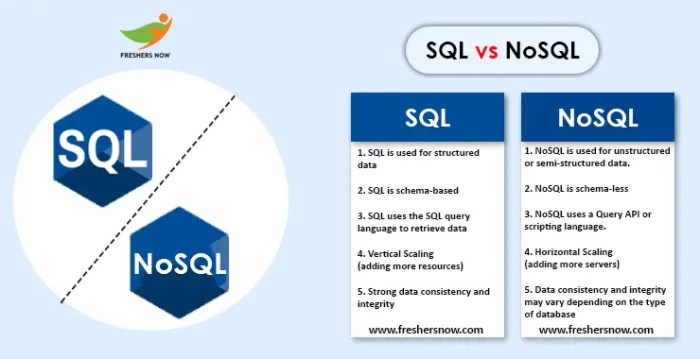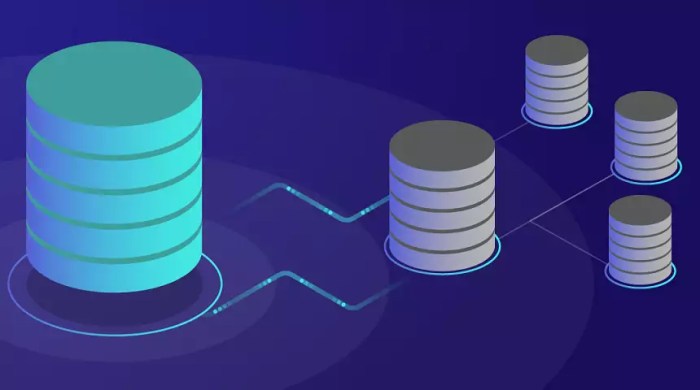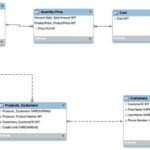What are the differences between SQL and NoSQL databases? This question opens the door to a fascinating exploration of two distinct database paradigms that have fundamentally reshaped how data is stored, accessed, and managed in the digital age. SQL databases, with their structured query language and rigid schemas, have long been the backbone of data management for many businesses, while NoSQL databases offer a more flexible and scalable approach, catering to the needs of modern, data-driven applications.
Understanding these differences is crucial for anyone involved in data architecture and application development.
SQL databases typically emphasize structured data with predefined schemas and a focus on relational data integrity, making them ideal for transaction-oriented applications. In contrast, NoSQL databases provide a variety of data storage models—such as document-based, column-family, and key-value—allowing for dynamic and unstructured data management. This versatility is particularly useful in big data and real-time web applications, where speed and flexibility are paramount.
Overview of SQL and NoSQL Databases
SQL and NoSQL databases represent two fundamental approaches to data storage and management, each with its unique characteristics and use cases. Understanding the differences between these two types of databases is essential for making informed decisions about data architecture, particularly as the landscape of technology continues to evolve. This overview aims to elucidate the key traits of SQL and NoSQL databases, along with their respective applications in modern data-driven environments.
Characteristics of SQL Databases
SQL databases, also known as relational databases, are structured systems that use structured query language (SQL) for defining and manipulating data. They are built on a schema-based architecture, which means the data structure is predefined, ensuring consistency and integrity. The fundamental characteristics of SQL databases include:
- Structured Data: SQL databases store data in tables with rows and columns, where each table represents a different entity.
- Schema-Based: A fixed schema defines the structure of the data, ensuring that all data entries follow the same format and data types.
- ACID Compliance: SQL databases adhere to ACID properties (Atomicity, Consistency, Isolation, Durability), which guarantee reliable transactions even in case of failures.
- Complex Queries: SQL allows for complex querying capabilities, including joins and subqueries, making it suitable for intricate data retrieval needs.
Features of NoSQL Databases
NoSQL databases provide a more flexible approach to data management, accommodating a wide variety of data models and structures. Unlike SQL databases, NoSQL systems do not require a fixed schema, which allows for scalability and adaptability. The essential features of NoSQL databases include:
- Schema Flexibility: NoSQL databases can handle unstructured and semi-structured data without requiring a predefined schema, enabling easy modification of data structures.
- Scalability: Many NoSQL databases are designed to scale horizontally, allowing for the addition of more servers to handle increased loads and storage requirements.
- Diverse Data Models: NoSQL encompasses various types of databases, including document, key-value, column-family, and graph databases, catering to different data storage needs.
- High Performance: NoSQL databases are optimized for high-speed transactions and can handle massive volumes of data efficiently.
Primary Use Cases for SQL and NoSQL Databases
The choice between SQL and NoSQL databases often depends on the specific requirements of a project or application. Different use cases highlight the strengths of each type of database:
- SQL Database Use Cases: Ideal for applications that require complex queries, transactions, and consistency, such as financial systems, enterprise resource planning (ERP), and customer relationship management (CRM) systems.
- NoSQL Database Use Cases: Suited for scenarios requiring high scalability and flexibility, such as big data applications, real-time analytics, social networks, and content management systems.
Data Structure and Storage

The differences in data structure and storage between SQL and NoSQL databases are fundamental to their design philosophies and applications. SQL databases operate on a structured query language and are typically defined by a rigid schema, while NoSQL databases embrace a more flexible approach, allowing for various data models that can adapt to different use cases.SQL databases utilize a table-based format where data is organized in rows and columns.
This structure supports a clear relationship among tables through the use of foreign keys, ensuring data integrity and consistency. The relational model is inherently designed to handle complex queries and maintain relationships between datasets efficiently. For example, in a SQL database, a `Customer` table can have a foreign key reference to an `Orders` table, allowing for robust data integrity through relational constraints.
Storage Models in NoSQL Databases
NoSQL databases, on the other hand, offer a variety of data storage models that cater to different application needs. These models include document-based, key-value, column-family, and graph databases. Each model has its unique approach to data representation and access, providing flexibility for developers.
Document-based databases
To maximize the benefits of business intelligence tools, effectively training your employees is key. This not only enhances productivity but also ensures that your team can utilize the tools to their fullest potential. For insightful strategies, check out this comprehensive guide on how to train employees on business intelligence tools.
These databases store data in documents, typically formatted as JSON or BSON. Each document can have a different structure, making it easy to accommodate changes without requiring a predefined schema. An example of this is MongoDB, where a `User` document might contain varying fields depending on the user profile, allowing for a more dynamic data structure.
Key-value stores
Choosing the right database management system is crucial for the success of any project. It’s essential to evaluate your specific needs, scalability, and performance requirements. For a detailed guide on making this decision, you can refer to this resource on how to choose the right database management system for projects.
This simple model stores data as a collection of key-value pairs. Each key is unique, and the value can be any type of data, making it highly performant for specific queries. Redis is a well-known example, often used for caching and real-time analytics due to its speed and simplicity.
Column-family databases
These databases store data in columns rather than rows, optimizing read and write performance for large datasets. Apache Cassandra exemplifies this model, allowing users to store and retrieve large amounts of data efficiently.
Graph databases
These databases focus on relationships between data points, representing information as nodes and edges. They are particularly useful for applications that require complex relationship queries, such as social networks. Neo4j is a popular graph database that excels in managing interconnected data.The choice between SQL and NoSQL largely depends on the application’s requirements regarding data structure, scalability, and complexity. With SQL databases ensuring data integrity through established relationships, and NoSQL databases providing flexibility in data formats, organizations can select the right approach to meet their specific needs.
Scalability and Performance
As organizations grow and data requirements expand, the selection of a database system becomes critical, particularly in terms of scalability and performance. Understanding the differences between SQL and NoSQL databases in these areas can significantly influence the architectural choices made by developers and database administrators. This section delves into the scalability options available for both types of databases, examines performance metrics under high loads, and compares response times for read and write operations.
Scalability Options for SQL versus NoSQL Databases
Scalability is a vital factor determining how well a database can handle an increasing volume of data or users. SQL databases traditionally offer vertical scalability, which means that performance is improved by enhancing the existing hardware resources. However, this approach has its limitations, as it eventually reaches a point of diminishing returns.On the other hand, NoSQL databases are designed with horizontal scalability in mind.
This allows them to handle increased loads by distributing the data across multiple servers. The following points highlight the scalability landscape for both database types:
- SQL Databases: While they can scale vertically through more powerful servers, this often results in higher costs and complexity in maintenance.
- NoSQL Databases: They support sharding, allowing data to be split across various nodes. This enables seamless growth as more servers can be added without significant changes to the existing infrastructure.
Performance Metrics Under High Loads
Performance metrics become crucial when databases are subjected to high loads, as they directly impact user experience and application efficiency. SQL databases, due to their structured nature and reliance on ACID transactions, may encounter performance bottlenecks during peak times. This is compounded by the necessity for complex joins and queries that can slow down response times.Conversely, NoSQL databases excel in performance metrics during high load scenarios, mainly due to their schema-less nature, allowing for faster data retrieval and fewer constraints.
Key performance indicators are as follows:
- Transaction Speed: NoSQL databases can handle a higher volume of transactions per second compared to traditional SQL databases, especially in read-heavy operations.
- Latency: NoSQL systems often exhibit lower latency due to the absence of complex query processing, which is common in SQL databases.
Response Times for Read and Write Operations
Response times are critical indicators of database performance, particularly for applications requiring real-time data processing. SQL databases typically exhibit longer response times for write operations due to the overhead of maintaining data integrity and enforcing ACID properties. In contrast, NoSQL databases offer significantly faster response times for both read and write operations.Consider the following comparative performance metrics:
| Database Type | Average Read Response Time | Average Write Response Time |
|---|---|---|
| SQL Databases | 50-100 ms | 100-200 ms |
| NoSQL Databases | 1-10 ms | 5-50 ms |
These numbers indicate that NoSQL databases can outperform SQL databases significantly under high demand, making them a suitable choice for applications that prioritize speed and scalability.
“Choosing between SQL and NoSQL is not just about the type of data stored but also how that data will be accessed and scaled.”
Query Language and Operations

An understanding of the query languages and operations in SQL and NoSQL databases is crucial for developers and data professionals. SQL, or Structured Query Language, is a powerful tool for managing relational databases, providing a rich syntax for querying and manipulating data. In contrast, NoSQL databases offer a variety of querying methods tailored to their non-relational structures, accommodating diverse data types and use cases.
This section explores the specific capabilities of SQL syntax and the various querying methods employed in NoSQL databases.
SQL Syntax and Capabilities
SQL is characterized by its declarative syntax, allowing users to specify what data they want without detailing how to retrieve it. The core operations in SQL can be grouped into four basic commands: SELECT, INSERT, UPDATE, and DELETE (commonly referred to as CRUD operations). Each command serves distinct purposes in data manipulation.
SELECT is used to retrieve data from one or more tables. The syntax typically follows this structure
“`sql SELECT column1, column2 FROM table_name WHERE condition; “`
INSERT adds new records to a table
“`sql INSERT INTO table_name (column1, column2) VALUES (value1, value2); “`
UPDATE modifies existing records
“`sql UPDATE table_name SET column1 = value1 WHERE condition; “`
DELETE removes records based on specified criteria
“`sql DELETE FROM table_name WHERE condition; “`SQL supports complex querying through JOIN operations, aggregate functions, and subqueries, enabling users to perform sophisticated analyses on relational data.
NoSQL Querying Methods, What are the differences between SQL and NoSQL databases
NoSQL databases employ a range of querying mechanisms depending on their data model, such as key-value, document, column-family, or graph structures. Each model presents unique querying capabilities, tailored to specific application needs.
Key-Value Stores (e.g., Redis) utilize a straightforward key-value pair query system. Retrieval is typically done by key
“`bash GET key_name “`
Document Stores (e.g., MongoDB) allow for retrieval and manipulation of entire documents using JSON-like syntax. Example of a query to find documents with specific criteria
“`javascript db.collection.find( “field”: “value” ); “`
Column-Family Stores (e.g., Cassandra) provide a more complex querying method that focuses on columns rather than rows. An example query might look like
“`cql SELECT column1, column2 FROM table_name WHERE condition; “`
Graph Databases (e.g., Neo4j) use graph-based queries to traverse relationships. For instance, retrieving nodes connected to a specific node can be done using
“`cypher MATCH (a:Node)-[r:RELATIONSHIP]->(b:Node) RETURN a, b; “`The flexibility of NoSQL querying accommodates a variety of data structures and use cases, providing developers with efficient tools for accessing and manipulating large datasets.
Comparison of CRUD Operations in SQL and NoSQL
The following table highlights the key differences in CRUD operations between SQL and NoSQL databases. Understanding these differences aids in selecting the right database technology based on project requirements.
| Operation | SQL Example | NoSQL Example |
|---|---|---|
| CREATE | INSERT INTO users (name, age) VALUES (‘Alice’, 30); | db.users.insert( “name”: “Alice”, “age”: 30 ); |
| READ | SELECT
|
db.users.find( “age”: $gt: 25 ); |
| UPDATE | UPDATE users SET age = 31 WHERE name = ‘Alice’; | db.users.update( “name”: “Alice” , $set: “age”: 31 ); |
| DELETE | DELETE FROM users WHERE name = ‘Alice’; | db.users.remove( “name”: “Alice” ); |
This table illustrates how SQL’s standardized syntax contrasts with the more varied approaches found in NoSQL databases, each designed to suit different types of data and querying needs.
Flexibility and Schema Design: What Are The Differences Between SQL And NoSQL Databases
The distinction between SQL and NoSQL databases is prominently showcased in their approach to schema design and flexibility. SQL databases operate under a fixed schema, demanding a predetermined structure for data storage. In contrast, NoSQL databases thrive on flexibility, allowing dynamic schema modifications that cater to evolving application needs. This adaptability often proves advantageous in modern application development.SQL databases are characterized by a structured schema that defines the organization of data within tables, including the types of data each column can hold.
Changing this schema often involves complex migrations and can lead to downtime, making it less responsive to changes in application requirements. For instance, in a relational database like PostgreSQL, altering the structure to add a new column may necessitate extensive planning and implementation.NoSQL databases, on the other hand, are designed to accommodate various data types and formats, providing superior flexibility.
Documents in a NoSQL database like MongoDB can easily evolve; new fields can be added or removed without disrupting existing data. This allows developers to iterate rapidly, adjusting the data model as new features are developed and requirements shift.
Schema Evolution Examples
Understanding schema evolution in both database types illustrates their flexibility. In SQL databases, a common scenario arises when a company decides to add a new feature requiring additional data. The process often includes:
- Assessing the impact on existing tables and relationships.
- Executing a migration script to introduce the new column.
- Testing to ensure data integrity and compatibility.
In contrast, a NoSQL database allows for immediate evolution. For instance, if a JSON document structure needs a new attribute, developers simply modify the document format. An example could be:
- Adding a “lastUpdated” timestamp to user profiles stored in MongoDB without affecting other users’ data.
- Removing an outdated “age” field from documents without requiring a major overhaul of the existing dataset.
Scenarios Favoring Flexible Schema
There are specific scenarios where a flexible schema becomes particularly beneficial compared to a fixed schema. These scenarios often involve rapid development cycles and changing requirements. Examples include:
- Startups and MVPs: New businesses often need to iterate quickly based on user feedback, making NoSQL’s flexibility ideal.
- IoT Applications: The diverse data types generated by IoT devices require a flexible structure that can adapt to new data formats easily.
- Content Management Systems: Websites with various content types benefit from NoSQL’s ability to handle unstructured data, such as multimedia files.
In summary, the contrasting approaches to schema design and flexibility between SQL and NoSQL databases highlight their respective advantages. While SQL offers structure and consistency, NoSQL provides the agility needed for modern applications that require rapid adaptation to new information and requirements.


